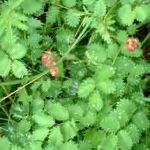| Common Name: |
Salad Burnet |
| Botanical Name: |
Sanguisorba minor |
| Genus: |
Sanguisorba |
| Family: |
Rosaceae |
| Native Location: |
S, W, and C Europe, N Africa, Canary Islands, W and C Asia |
| Cultivation: |
Moist, well-drained soil in sun or partial shade. |
| Propagation: |
Propagate by seed sown in autumn or spring; by division in autumn or spring. |
| Harvest: |
Leafy parts are cut before flowers open and dried for use in infusions, liquid extracts, and tinctures. Roots are lifted in autumn and dried for decoctions. |
| Hardiness: |
Z5 |
| Parts Used: |
Leaves |
| Properties: |
A cooling herb with a cucumber flavor. |
| Culinary Uses: |
Young leaves and leaflets are added to salads, sandwiches, soups, soft cheeses, and summer drinks; also used as garnish. Dried leaves are made into tea. |
| Bibliography: |
The Encyclopedia of Herbs by Deni Bown Copyright © 1995,2001 Dorling Kindersley Limited pg. 358 |

